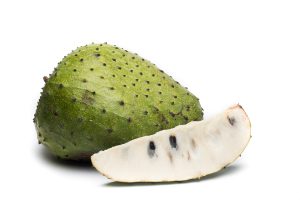
Have you ever noticed how fruits and vegetables that other cultures use seems to get missed in North American culture. They never seems to make it to the local supermarket in North America? But if you travel, you have like encountered amazing ingredients. For me, that was discovering durian in Thailand, which smells like a rotting dead bod and tastes like heaven.
I recently discovered soursop, which has a similar taste to durian and jackfruit, although there are key differences.
The three exotic fruits are usually oval in shape and from an evergreen tree. They have a spiny skin, although the soursop can be more pear shaped than oval. “Duri” in durian means spike or thorn in Malay-Indonesian languages.
Today let’s talk more about soursop as it can be found in North America, although not always fresh. (You won’t find it at your local chain grocery store (in Canada and the U.S. at least.) It also has a reputation as a traditional natural cancer fighter, with some support from modern medical research.
You may encounter soursop under other related words. The most common is guanabana, a Spanish word for soursop. Or it is also known as graviola.
It tastes like a combination of pineapple and mango. That said, some people describe it as a banana strawberry flavor with coconut and even sour notes.
Here is a great place to start with soursop – as a delicious tropical drink. You can buy soursop fruit in the U.S. either fresh soursop fruit or as frozen soursop pulp.
And finally, if you are not convinced, consider that Mark Twain said soursop (or its cousin cherimoya, which is similar like various apples are different but similar) embodied deliciousness.
Soursop is used in shakes, ice cream, drinks, and sweet tropical desserts. It has creamy pulp. It is no wonder it also referred to prickly custard pear or custard apple.